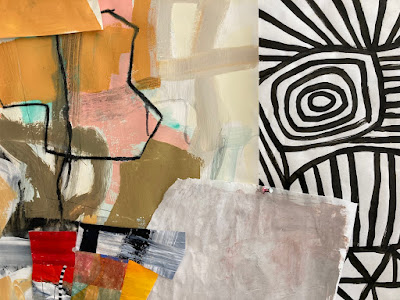How much studio time do you give to experimenting, exploring, not trying to make art? In last Friday's zoom workshop, 5 Ways to Get Un-Stuck (you can still buy the recording here), I got a lot of questions that implied a need to make finished work out of everything we do in the studio. While I am demonstrating "mashing sh!t together" or practicing 5-minute paintings, some of the questions are some version of: What Happens Next? How Do You Finish It? How Do You Make This Into Finished Work?
The implied belief is that we are wasting our time/materials/resources if we are not working towards a product, a finished piece. This belief, so ingrained in our daily lives, is probably one of the most challenging habits of mind to break. And yet I know that if I am trying to make good art, I make mediocre contrived, superficial art. When I get absorbed in a visual inquiry, absorbed in process, allow myself to go "off-topic" or make a mess or try combining ideas to see what happens... this is when the good stuff shows up.
The practices I demonstrated in 5 Ways to Get Un-Stuck do not result in finished works. That is the point. They are designed to remove the pressure or goal of The Finished Piece so that you can practice being in the mindset of inquiry and experimentation. Practicing the mindset is, to me, a worthy goal. It is worthy of our time and materials. You can always paint over, re-use the paper-canvas-board whatever your substrate is. And if the cost of paint holds you back, use cheaper paint for the experimental practices.
Here are a few of my mash-ups from last winter; they are 11"x14" on Bristol












